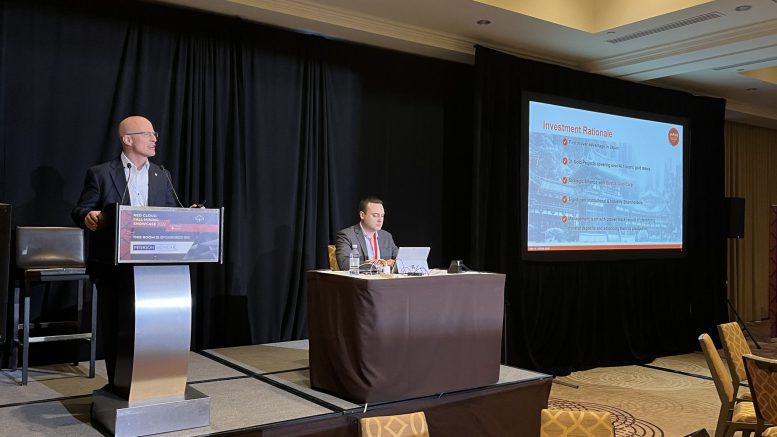High-tech manufacturing, beautiful art and good food are a lot more commonly associated with Japan than gold.
But Vancouver-headquartered explorer Japan Gold (TSXV: JG) might be a catalyst to start shifting that association.
Of the four rigs the company currently has turning in Japan, it is mobilizing two to drill on the northern island of Hokkaido “before the snow really flies this year,” said chairman and CEO John Proust at the Red Cloud Fall Mining showcase in Toronto on Thursday.
Ten years after the East Asian country amended its mining law, Japan Gold took advantage of those changes and in 2014 became the first foreign explorer to apply for prospecting rights. It operates in Japan through a joint venture with Barrick Gold (TSX: ABX; NYSE: GOLD), known as the Barrick Alliance that was formed in 2020. The Alliance covers most of the exploration projects, with Japan Gold acting as the manager of each one, subject to Barrick’s right to become manager at any time. Newmont (TSX: NGT) holds a 10% interest in Japan Gold.
Japan Gold is exploring on Hokkaido, the main island of Honshu and the southern island of Kyushu, covering more than 2,000 sq. km over 31 projects. All the projects are situated in areas of historic gold mining or gold occurrences, most of which have sat untouched since 1943 when the Japanese government closed gold mines in favour of base metal mines or factories to support the Second World War effort.

We have a first mover advantage in Japan, says Japan Gold CEO John Proust. Blair McBride photo
“There’s this incredible legacy of closed mines in Japan, and a wonderful endowment of gold resources that are yet to be exploited,” Proust said.
Most of the projects cover low-sulphidation epithermal gold areas that Proust said resemble Japan’s only producing gold mine, Sumitomo Metal Mining’s Hishikari mine in southern Kyushu.
The 205.1-sq.-km Ikutahara project, which covers 20 historic gold mines in northeast Hokkaido, is Japan Gold’s most advanced project. It is located about 250 km northeast of the prefectural capital of Sapporo.
Nine holes in that region are currently being completed, with six in the Saroma Valley and three in the Kitano-o East prospect. The Saroma holes, drilled between July and September came to 1,308.8 metres, with assay results expected by early December.
Seven other holes that were finished this June expanded the prospect area.
Of 11 diamond drill holes completed in 2021, noteworthy results include 20 metres of 6.3 grams gold per tonne and 15.7 grams silver per tonne in hole IKDD21-010; and 0.5 metres of 1,395 grams gold and 768 grams silver in hole IKDD21-008.
On the far southeast end of the Japanese archipelago, the government has approved several drill programs at Japan Gold’s 48.7-sq.-km Ohra-Takamine project in Kagoshima Prefecture on Kyushu, inside the Hokusatsu-Kushikino mining district where the Hishikari mine operates.
While Japan Gold holds a 100% interest in Ikutahara and Ohra-Takamine outside of the Barrick Alliance, Newmont has a right of first refusal to become a joint venture partner in those projects.
Under the Barrick Alliance, Barrick chose three projects in Hokkaido, one on Honshu and two in Kyushu to advance to a three-year second evaluation phase of geophysics, drilling and assaying, which the gold giant will solely fund. There are two other project areas in Hokkaido and one on Kyushu that Barrick might add to the second evaluation phase.
“It’s going to be a very exciting year next year as Barrick starts to drill the projects that are in the advanced portfolio,” Proust said.
Addressing concerns about hesitation by Japanese authorities to welcome a foreign explorer, Proust said that while Japan has largely been overlooked by international mining interests for several decades, it amended its mining laws partly to spur more economic development.
“They did that… because the northern island of Hokkaido and the southern island of Kyushu are very economically depressed. They were looking for something to really restart that and they identified the gold mining industry that might be that catalyst,” he said.
The CEO said he also recognized that Japan lacks capacity for drilling, with much of its drilling activity focused on the geothermal industry rather than on mineral exploration.
“That’s why we have our own teams of geologists, field assistants [and] permitting team…that’s why we took a really aggressive approach in terms of building our own group and bringing in big partners early to help us advance it,” Proust said.
He added that the permitting process is becoming smoother as governments in Japan become more familiar with what the company is trying to accomplish.
Japan Gold shares were trading at 28¢ on Thursday afternoon in Toronto, in a 52-week window of 20¢ and 35¢, giving it a market cap of $62.9 million.


Be the first to comment on "Japan Gold drills to revive nation’s mostly-dormant gold mining industry"